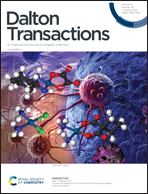Pyridine-di-phosphonates as chelators for trivalent f-elements: kinetics, thermodynamic and interfacial study of Am(iii)/Eu(iii) solvent extraction†
Abstract
The fractionation of high-level radioactive waste from nuclear power plants simplifies the handling of its components, and facilitates the reduction of radiotoxic effects on the environment. The search and study of new ligands for solvent extraction, as one of the methods in fractionation, remains a complex and important research task. In this work, four pyridine diphosphonate ligands were synthesized. These ligands are part of the class of the N,O-donor extractants, which are selective towards Am(III). The separation factor SF(Am/Eu) for the best extractant reached values up to 10. The influence of the substituents on the efficiency of extraction and complexation of trivalent f-elements, the kinetics of extraction, and the behavior of the ligand at the interface were described. The effect of nitric acid concentration on the extraction was shown. The stoichiometry of the complexes was determined by slope analysis in solvent extraction experiment and verified by spectrophotometric titration in acetonitrile. Liquid tension experiments with a pendant drop method revealed the interfacial properties of the ligands in “F-3 solvent/H2O” and “F-3 solvent/HNO3” systems. The relationship between the surface activity and the ligand structure was shown. Studies of the extraction kinetics were performed in a modified Lewis cell. The effect of the ligand structure on the extraction rate was shown. The DFT calculation with the B3LYP density functional was used to explain the extraction properties of the ligands, including selectivity. The calculation of the pre-organization energy of the ligands explained the kinetics and extraction patterns for the studied series.



 Please wait while we load your content...
Please wait while we load your content...